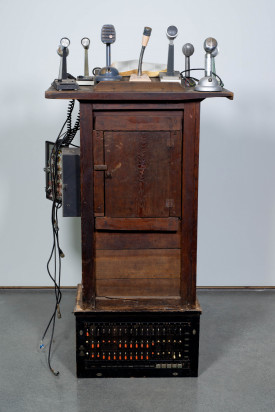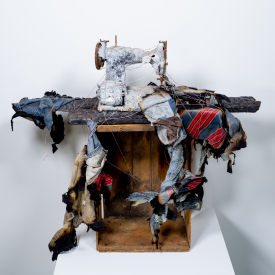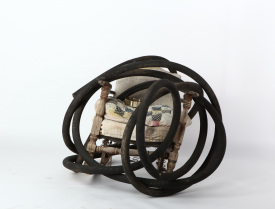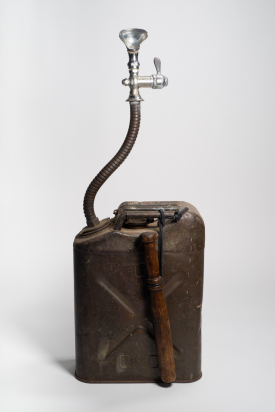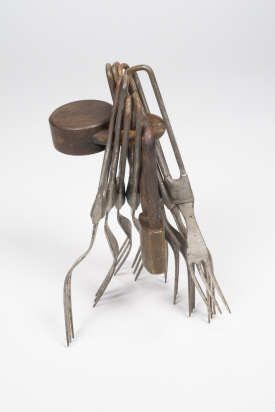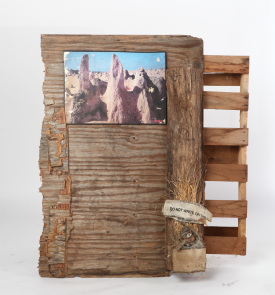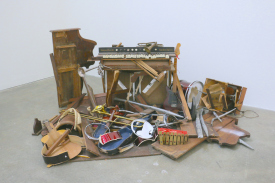Lonnie Holley
by Theodore Rosengarten
This essay is dedicated to the memory of William S. Arnett, art historian and collector, friend and patron of Lonnie Holley, and creator of the Atlanta-based Souls Grown Deep Foundation, dedicated to spreading the word and exhibiting the treasures of the region’s African American visual tradition. Bill passed away on August 12, 2020.
In spring, 1961, an eleven-year-old boy from Birmingham, Alabama, broke out of jail with four older boys. The youngster had landed in the juvenile lockup for violating a curfew imposed by the city’s Commissioner of Public Safety, Eugene “Bull” Connor, a vicious foe of Civil Rights who was getting ready to give a hot welcome to Freedom Riders coming south on buses to protest segregation. The boys stole a car and didn’t get far before they wrecked it and were quickly jailed again. The next morning, without so much as a court hearing, they were transported to a corrections center called the Alabama Industrial School for Negro Children at Mt. Meigs. What kind of school was this? Denny Abbott, a former probation officer, wrote in a memoir, “It was my job to deliver black children to a slave camp on the outskirts of Montgomery, Alabama.”
Just as under slavery, when African Americans were barred from learning to read and write, juvenile convicts were put to work—on the cotton “plantation” and the vast truck farm, at the cannery and the slaughterhouse. Punishment for failing to pick enough cotton, or for bruising the watermelons, or for any infraction of the rules was swift and cruel. “Turn over and put your dick in the hole, while I whip your ass.”
Who Locked Up the Rules? (2018), the artist asks in a piece that fuses a padlock against a carpenter’s wood rule, standing upright as if to form a gate. Beyond the gate you perhaps could find legal process, justice, family, relief from pain.
Memories and dreams keep bringing the mature Holley back to Mt. Meigs. The chain gang made up of older boys inspired the artist’s piece by that name (Chain Gang, 2018). Another padlock greets us, this time fastened to an old army mess kit. It takes a moment to see that the skeletal figures do not signify emaciated people but are forks, for eating, and we can imagine them being handed out to each prisoner in the field at lunch.
The microphones atop the disabled radio console in Manipulating My Dispatch (2017) could be the tools of a singer, a speech-maker, a police or ambulance dispatcher. One of them could have been the mike that sent the boy off to Mt. Meigs, or the one that called for the school director to come to the office when the boy’s grandmother came to pick him up in the fall of 1963. She brought him the news that his name was not Tonkie McElroy, the name he had arrived with, Tonkie for a honky-tonk, his first real home, and McElroy for the proprietor who had kept him, but Lonnie Bradley Holley. Momo, as Lonnie came to call her, was his father’s mother. Her son, A. J. Bradley, had recently died, but Lonnie’s mother, Dorothy Holley, was yet living. Although it was Lonnie’s ambition to find his mother, who had given him away when he was one-and-a-half, he was in no hurry and stayed with Momo and Uncle Jessie, accompanying them each morning to a trash dump called City Light. They would take long rakes and comb the trash for copper and brass before it was bulldozed and rolled into a pit. They were joined by Lonnie’s cousins and some of his sisters, once they were big enough. “My whole family was recyclers and know how to reuse things,” he recalls.
One day he went to find his mother. Turning a corner he saw many children playing in the street. These were his sisters and brothers. Lonnie went up to the porch of her house.
“Who is you?” asked a man named Daddy James.
“My name is Lonnie Holley.”
“Dot,” Daddy James called out. “There is a boy here that says his name is Lonnie Holley.”
A very large woman came running to the porch. She burst out crying, threw her arms open, and sobbed, “My son, my son, my son.”
Lonnie wasn’t so sure. “I was questioning in my own self. Is this really your mama?” Then his grandpa came, his mother’s father. He pulled up in his truck and the children said, “Lonnie is here.”
“Grandpa said, ‘Yes, Lord. Yes, Lord. Yes, Lord, I’m now forgiven.’”
Forgiveness is not an empty word to Lonnie. While many graduates emerged from Mt. Meigs “prepped for prison” and “ready to kill,” Lonnie had a new life to live, a new identity to build. It would be a long, crooked road of self-discovery that would take him around the world. He would savor the recognition he receives abroad as an artist and as an American, plain and simple, because what else is he? In Defiance (2018) the American flag is laid neatly across a surface that may be a side table, a sewing table, or an operating table, better to repair the rip in the fabric, for which procedure the artist-healer has assembled spools of thread. The flag is peaceful and domesticated, defying the histrionics it might convey outdoors in the hands of insecure patriots. The sewing machine in The Threads that Held Us Together (2018) has been through a house fire; otherwise it could do the job quickly. Reduced to a noble ruin, it holds fast to scorched patches of clothing by threads that cross helter-skelter, “by any means necessary,” Lonnie would say, quoting a favorite line from Malcolm X. “My art is asking you to unravel my complications,” says Lonnie, not least of which are his gentle irony and striking humanity.
Lonnie Holley
Born in Birmingham, Alabama (1950)
Lives and works in Atlanta, Georgia
Since 1979, Holley has devoted his life to the practice of improvisational creativity. His work incorporates natural and man-made objects, already imbued with cultural and artistic associations, into narrative sculptures that commemorate places, people, and events.
Holley’s work is included in the collections of the Smithsonian Institution, Washington, D.C.; and Whitney Museum of American Art, Metropolitan Museum of Art, and the United Nations, all in New York, NY. In January of 2014, Holley completed a one-month artist-in-residence with the Robert Rauschenberg Foundation in Captiva Island, Florida, site of the acclaimed artist’s studio.
Holley is also a prolific and eclectic musician and has toured internationally for many years. He has been making and recording music privately since the early 1980s, performing and collaborating with groups such as Deerhunter, War on Drugs, Animal Collective, and Bon Iver. Holley’s latest EP National Freedom was released July 2020.
Lonnie Holley’s work was featured at the Halsey Institute in 2015 in Something to Take My Place. A catalogue by the same title was published by the Halsey Institute in 2015.
Theodore Rosengarten
Dr. Theodore Rosengarten is the Zucker-Goldberg Chair Emeritus in Holocaust Studies at the College of Charleston, and Associate Scholar in Jewish Studies at the University of South Carolina. He received his AB from Amherst College and Ph.D. in the History of American Civilization from Harvard University.
Rosengarten is author of All God’s Dangers: The Life of Nate Shaw and Tombee: Portrait of a Cotton Planter, as well as numerous essays on art and literature. A MacArthur Fellow and recipient of the National Book Award, and the National Book Critics Circle Award, Rosengarten regularly leads studies abroad to Europe where his students say he does his best teaching. He and his wife Dale collaborated on two acclaimed books that accompanied national traveling exhibitions curated by Dale—A Portion of the People: Three Hundred Years of Southern Jewish Life, and Grass Roots: African Origins of an American Art.
You can read more about Lonnie Holley, as he told his story to Rosengarten, in a piece called “Blackbirds” that appeared in Something to Take My Place: The Art of Lonnie Holley, edited by Mark Sloan and Lizz Biswell, the catalogue of the 2018 Halsey exhibition by that name.



